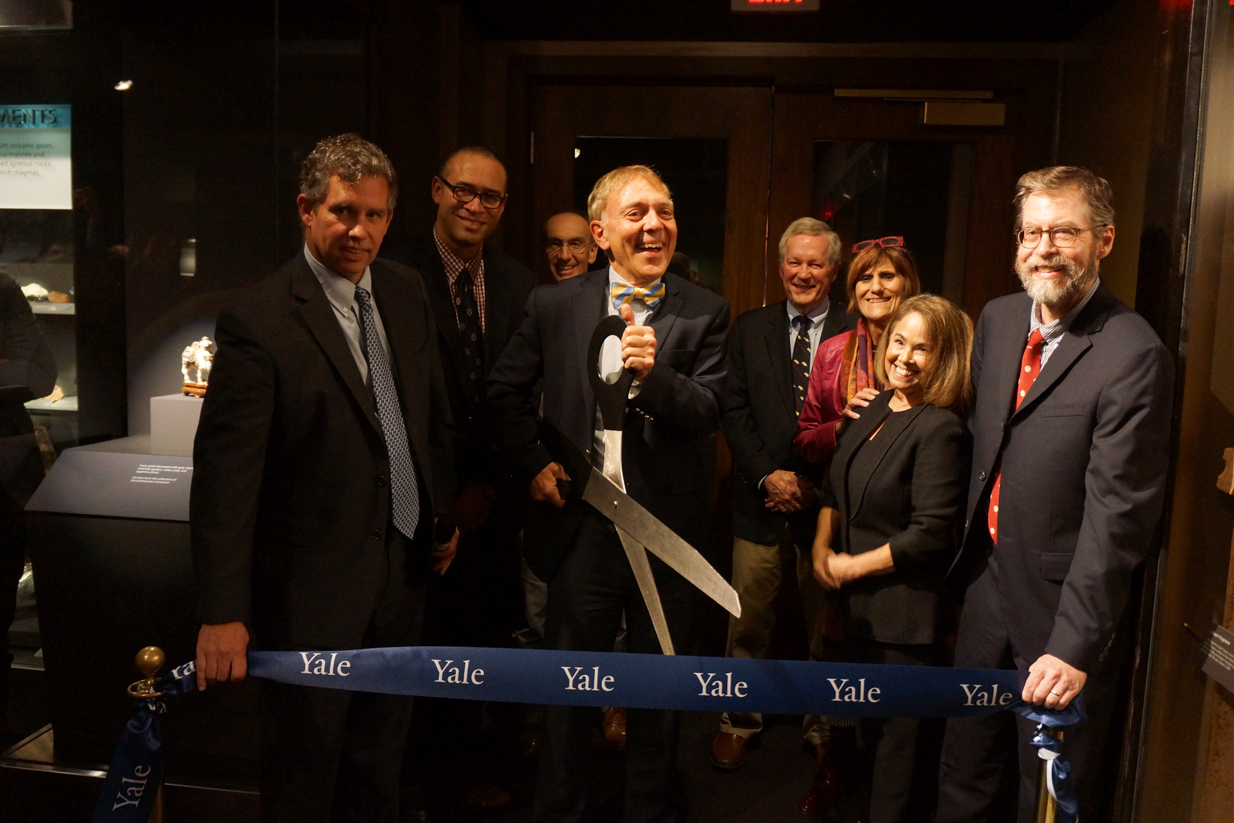
Starting on Oct. 23, a 2,000-pound glowing quartz crystal will greet visitors at the David Friend Hall gallery in the Yale Peabody Museum of Natural History. This Namibian quartz specimen is one of over 150 premier gems and minerals that compose the inaugural exhibit within David Friend Hall — a new state-of-the-art space for exhibits of this kind.
The gallery was unveiled to members of the Yale community and museum affiliates at a Thursday ribbon-cutting ceremony. Attendees included University Provost Benjamin Polak and University President Peter Salovey’s wife Marta Moret SPH ’84, who both spoke at the beginning of the event.
“This is a space that is meant to be different than anything else in the museum,” Peabody Museum Director David Skelly said. “It’s a place that is not overtly pedagogical. It’s meant to inspire people to learn, it’s meant to fire their curiosity and it’s meant to be a place that you just come in and experience.”
David Friend Hall will complement the museum’s existing Hall of Minerals, Earth and Space, adding to one of the nation’s oldest and most comprehensive collections of gems and minerals. The 2,300-square-foot gallery will officially open to the public next weekend, in time for the 150th anniversary of the museum’s foundation. The yearlong renovation was funded by a $4 million gift from David Friend ’69, the founder of the online backup service Carbonite, in June 2015.
Friend has been interested in mineralogy since childhood, he said in his speech, and is a member of the Peabody Leadership Council, as well as the museum’s newly established museum mineral council. An avid collector of gems and minerals, Friend contributed several specimens to the new gallery from his personal collection.
“What people want is a sense of wonder,” Friend said in his speech at the ribbon-cutting ceremony. “The function of a museum, in my view, especially for little kids, is not so much to teach, but to inspire a desire to learn. I think that’s how you get people interested in science — you create the desire to think about, ‘how did this all happen?’”
The design of David Friend Hall is different from the traditional arrangement of natural history museums, Skelly said. Instead of organizing the gems and minerals in conventional display cases accompanied by large, text-filled signs, the pieces in David Friend Hall are meant to stand alone in their ability to enthrall visitors.
To enhance the presentation of the specimens, the museum invested in features such as custom lighting and display cases constructed from anti-reflective glass. Skelly likened the exhibit to an art gallery.
Peabody Museum Exhibit Designer Laura Friedman, who also designed the adjacent Hall of Minerals, Earth and Space, along with several of the museum’s temporary exhibits, was in charge of the David Friend Hall project.
“What was really exciting for me was pulling together pieces that would harmonize with and complement each other,” Friedman, who has been at the Peabody for 15 years, said. “We wanted it to be a very minimal space, where the pieces really would be the center of the focus.”
In addition to showcasing some of the world’s finest specimens of gems and minerals, David Friend Hall will also serve as a multipurpose programming space for the museum. With a seating capacity of 126 people, the gallery will double as a venue for public events and activities organized by Yale professors and students, Skelly said.
While the exhibit itself is permanent, the contents of the gallery will change over time, Peabody Museum Director of Public Programs Richard Kissel said. The big specimens that anchor the display will remain as centerpieces of David Friend Hall, but other specimens, many of which are on loan from private collections around the country, will rotate in and out of the gallery, he added.
“The adjacent mineral gallery is organized by the science of mineralogy, but this gallery is organized by aesthetics,” Kissel said. “We would love for people to enter the space and connect with the objects on their own personal level, and we really encourage people to just focus on the beauty and the diversity of the material in this space.”
In an effort to make the science behind mineralogy more relatable and accessible to the public, the museum also plans to launch a new app for David Friend Hall. The app, which is being co-developed by students, will allow users to design their own tours and interact with displays through Bluetooth technology, according to Kissel.
This team of undergraduates is headed by computer science major Leo Shimonaka ’18, alongside Duncan Keller GRD ’21, who is responsible for the in-app presentation of scientific information regarding the exhibits.
Admission to the Yale Peabody Museum of Natural History will be free for the duration of its anniversary weekend.







